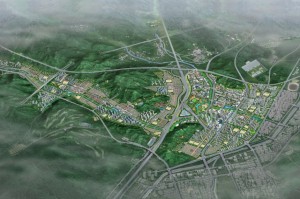By Younghoon Lee
Pangyo, one of the districts of the satellite city of Seoul is a home of 8 million populations in South Korea. The district is planned and constructed by the Korean government and the department of construction and the transportation, from 2001 to 2009. This new planned city is situated between the wealthy two regions: Gangnam, a worldwide famous fancy region in Seoul and Bundang, a pre-existing planned satellite city of Seoul where high-income population resides.
The public housing of the city shows distinctive characteristics compared to that of other cities or in other countries. First, the city was planned for residential purpose and to disseminate population from urban centers of Seoul. However, unlike other cities’ public housing, the population the government aimed to draw in was the high-income residents. The city was not for the poor or less-educated who did not own their houses, but the wealthy people who already had their own properties. Second, as the target population is high-income residents, the objective of the public housing department was to construct a low-density neighborhood.
In terms of the public housing itself, it is considered as one of the biggest failures of the government real estate policies. The original purpose of the city was to disseminate the wealthy population in Gangnam and stabilize the real estate market. In early 20s, Korean real estate market was fluctuating and the price of house property was soaring, making low-income population homeless. The government determined, in the market economy sense, that the problem lies within the lack of supply compared to the rising demand of the real estate. The solution was to develop Pangyo region to supply house properties to the market, thereby stabilize the market and decrease the price of house to affordable state to the low-income population. However, this grand attempt of the government was found to be a great failure. The Gangnam residents did not reside in Pangyo, but they only invested on the real estate and left it vacant. Moreover, the real estate market soared even higher, aggravating the problem. The government followed the simple logic of market economy, but several external and internal factors that influenced the project made the city meaningless.
The political intervention, which shifted the purpose of the plan from constructing the luxurious town to the supply of cheap housing, made the town less attractive to both wealthy residents and low-income population. The shift of the leading party in 2003 changed the fate of Pangyo, which was only in the planning process at the time period. The changed government at the time saw the Pangyo development as their opportunity to gain popularity toward the poor and less-educated population. Formerly planned as luxurious town, Pangyo plan added the purpose of supplying cheap housing to the low-income residents. The household was originally planned as 19,700, but the government intervention changed it in to 29,700, most of the added household consisting of small-size housing. However, the region targeted for development did not expand, making the region more compact and densely-populated region. This seriously affected the original purpose of the plan. The low density housing, which wealthy residents would feel suitable did no longer exist in the Pangyo plan. Rather, expectation of the influx of low-income residents in the regions drove away potential wealthy residents. Pangyo was also no longer popular to the poor population, because the price was already too high for purchase. Even though most of the housing were developed by the government, the low affordable price for low-income population could not be formed. The Pangyo region, before it was developed, was having a huge interest to investors because of its geological location. So the land property of the region was already high. The plan of the government in 2011 of constructing the luxurious town in Pangyo region even boosted the investment interest. Even though the government tried to adjust the price to the affordable state, the minimum price it could make was already too high for the low-income population to purchase. The result is that the wealthy residents in Gangnam purchased the housing properties in terms of investment and did not reside in the region. Expecting that the town was formerly constructed as the luxurious town and considering its geological location which is between Gangnam and Bundang, investors thought the value of the public housing in the region will rise. As the government tried to adjust the price for the low-income residents, The initial price was quite affordable for the high-income population. This made Pangyo a huge real estate market to invest, which eventually boosted the real estate market to fluctuate. Because of political intervention and governmental inconsistency, neither the wealthy population was disseminated nor the real estate market was stabilized. Even though the Pangyo city successfully managed to create a successful environment to reside, the public housing itself was subjected to political intervention and became another problem in the real estate market the government have to solve.
References
Lee, Y.J. Distant, Medium and Close-Range Views of a Detached Housing Complex in Pangyo. Seoul: Space Press, 2011. Print.
Shin, Roy. The Private Provision of Capital for Public Housing Development: A Cost – Benefit Study of the Seoul Housing Project. Indiana University, 1995. Print

